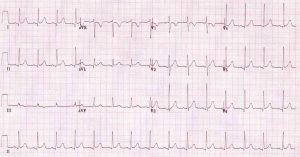“Lately I’ve been feeling really isolated and trapped…I think quarantine has been taking over my life,” I sighed.
“Hmm…let’s see. Have you tried taking a break outside every once in a while? Going for a walk or just doing nothing in the park?” my therapist asked.
“If I wanted to do nothing, I could just do that in my room,” my homebody self replied.
“Actually, you know, there has been a ton of research proving that nature has health benefits for us.”
Interesting, I thought. I had heard about these benefits but didn’t quite realize how much I might need them. And coming from my therapist, I figured I should actually make time for the outdoors in my day. But as someone who prefers to hear the explanations behind such recommendations, I wanted to understand the connection between the observed benefits of nature on human health and the science behind them.
One of the first things I discovered was that the physical and mental advantages of nature originated from humans’ evolutionary past with hunting and gathering. Mobile ways of life required proper knowledge of the surrounding species and landscapes, and as a result, hunters and gatherers spent at least 3-5 hours outdoors everyday. By spending this extensive amount of time in nature, humans developed an almost innate connection with it. Specifically, in the field of evolutionary psychology, the Biophilia theory emphasizes humans’ “preference for natural environments and subconscious affiliation for other living organisms.” Due to centuries of bonding with other organisms and the outdoors, humans have undergone “prepared and counter-prepared learning that [have shaped] our cognitive and emotional apparatus.” This innate connection with nature is “…reflected in the choices we make [and] experience expressed…” Further, the theory emphasizes that the resulting effects on humans have been proven to better physical and mental health.

One of nature’s benefits is increased relaxation. This connection between the outdoors and relaxation was explored in a study where 25 participants were exposed to either natural scenes with greenery or man-made scenes with concrete buildings, and exposed to a mental stressor immediately afterwards. Specifically, researchers used “an accompanying social-evaluative threat …[which] was designed specifically to elicit cardiovascular stress responses.”. Electrocardiogram (ECG) heart rate data during stress recovery was measured which displayed the participants’ heart rate variability (HRV). This HRV records the time variation between each heartbeat and quantitatively measures the autonomic nervous system (ANS) activity. Specifically, the sympathetic (SNS) and parasympathetic nervous systems (PNS) comprise the ANS which lead to “flight or fight” or “rest and digest” responses respectively; these systems maintain an antagonistic relationship to regulate the body’s involuntary physiological processes. The data from the study displayed that HRV increased during stress recovery if the participant was first exposed to a natural scene; this result reflected a slowed ANS state which correlates to a more relaxed state, or PNS simulation. This increase in relaxation can be attributed to the heavily-oxygenated fresh air outside, which leads to a greater uptake of serotonin in the brain; oxygen plays a role in converting tryptophan to 5-hydroxy-tryptophan, an intermediate in the formation of serotonin. Since this hormone leads to less anxiety, these discoveries indicate that nature produces feelings of relaxation!
Another one of nature’s benefits is an increased ability to concentrate. Environmental psychologist Stephen Kaplan states that when we work without breaks, continuous attention is required and this high level of concentration can lead to burn out, a phenomena often called “attention fatigue”. However, studies show that attention fatigue is only temporary and after a period of time, the mental state resets, renewing concentration once again. The Pomodoro Technique is one concentration method that underlines this phenomena; after 25 minutes of work, a 5 minute break is suggested and after 4 cycles, a half hour break is suggested. Such mental rejuvenation is necessary as the brain requires rest just as muscles in our body do after a physical workout. Interestingly, nature can expedite this recovery process as just two hours of exposure to nature per week “engage[s] the mind effortlessly, providing a respite from having to deliberately direct attention.” This effortless engagement brings awareness of one’s “present sensory input without cognitive elaboration or emotional reactivity, and is associated with improved task performance.”
In one study, participants walked for 25 minutes through an area with man-made structures, through a park, and then again through a trafficked intersection; the resulting electroencephalogram (EEG) brain waves demonstrated “lower levels of frustration and arousal” when the volunteers passed through the park. Recorded EEG data after the entire walk displayed higher levels of engagement and concentration than before. As a result, nature allows for effortless engagement as our brains are still processing sensory information but don’t have to perform high-level functions and simultaneously inhibit distractions; this temporary reset allows for sharper attention later.

In addition to the mental health benefits, nature also provides physical health benefits. Simply existing in nature can lead to “lower probabilities of cardiovascular disease, obesity, diabetes, asthma hospitalization, mental distress, and ultimately mortality.” These diseases can be a result of prolonged stress, specifically due to high levels of the hormone, cortisol, which functions in an activated SNS. However, since nature stimulates the opposing PNS by enabling a more relaxed mental state; the chances of these diseases are lowered. Additionally, Vitamin D, or “calciferol” is produced when UV light from the sun stimulates this vitamin’s production in the body. This process enables calcium to be properly absorbed in the body, which is extremely beneficial for bone growth and development. Nature, as a result, exhibits many physical health benefits as well!
By exploring the explicit connection between nature and health benefits, I have started to understand why my therapist suggested stepping outdoors for a break. From increased relaxation, to more concentration, and even physical health benefits, exposure to nature has proven advantageous for humans. Especially during this COVID-19 pandemic, stepping into nature may be the stress-relief therapy we are all looking for.
Sources:
https://www.ncbi.nlm.nih.gov/books/NBK539845/
https://www.health.harvard.edu/blog/heart-rate-variability-new-way-track-well-201711221278
https://www.upr.org/post/paradoxical-link-between-mental-health-and-oxygen
https://www.ncbi.nlm.nih.gov/pmc/articles/PMC3699874/
https://www.ncbi.nlm.nih.gov/pmc/articles/PMC1448497/
https://www.nature.com/articles/s41598-019-44097-3
https://ods.od.nih.gov/factsheets/VitaminD-HealthProfessional/
https://www.nature.com/articles/srep11610
https://kids.frontiersin.org/article/10.3389/frym.2014.00005
https://www.frontiersin.org/articles/10.3389/fpubh.2016.00260/full
https://www.pdfdrive.com/lehninger-principles-of-biochemistry-books.html
https://e360.yale.edu/features/ecopsychology-how-immersion-in-nature-benefits-your-health